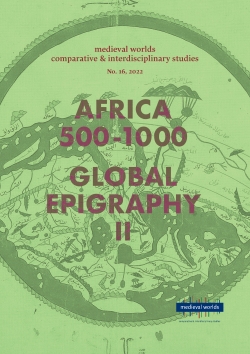Andreas Rhoby
S. 195 - 209
doi:
10.1553/medievalworlds_no16_2022s195
Verlag der Österreichischen Akademie der Wissenschaften
doi:
10.1553/medievalworlds_no16_2022s195
Abstract:
The use of the term xenos (ξένος) has a very long tradition in the Greek language. First used in Homer’s epics, it can have various meanings. Basically, the word means “foreigner”/ “stranger” but it also designates the “guest-friend”. As early as in Aeschylus, the adjective denotes “foreign” in the sense of “extraordinary”/“unusual”. The term xenos is also employed in inscriptions. The most famous ancient inscription using xenos is transmitted in Herodotus; it is the well-known address to the wandering stranger who is asked to tell the people in Sparta that he has seen the fallen Lacedaemonians at the Thermopylae. In late antique and Byzantine inscriptions (as well as in literary texts) the address xene is very often employed in (metrical) epitaphs. As in the famous Thermopylae epigram, the xenos is asked to stop, to have a look at the tomb and think of the deceased. Two further meanings of xenos are used very often in Byzantine metrical inscriptions: xenos (and its female form xene) is a very common term for monks (and nuns); they have escaped the worldly life and are xenoi on earth. In many cases xenos is employed in the sense of “extraordinary”/“unusual”; this is especially true for the description of buildings and various objects to which the inscriptions are attached but, e.g., also for inscriptions on reliquaries in order to describe a saint’s qualities. In this contribution, I will describe the various meanings of xenos from Antiquity onward with a specific focus on Byzantine metrical inscriptions.
Foreigner, Stranger, Epigraphy, Byzantium, Meter, Greek
Published Online:
2022/06/30 07:48:24
Object Identifier:
0xc1aa5576 0x003d895f
Rights:All rights reserved.For questions regarding copyright and copies please contact us by email.
medieval worlds provides a forum for comparative, interdisciplinary and transcultural studies of the Middle Ages. Its aim is to overcome disciplinary boundaries, regional limits and national research traditions in Medieval Studies, to open up new spaces for discussion, and to help developing global perspectives. We focus on the period from c. 400 to 1500 CE but do not stick to rigid periodization.
medieval worlds is open to submissions of broadly comparative studies and matters of global interest, whether in single articles, companion papers, smaller clusters, or special issues on a subject of global/comparative history. We particularly invite studies of wide-ranging connectivity or comparison between different world regions.
Apart from research articles, medieval worlds publishes ongoing debates and project and conference reports on comparative medieval research.
Editorial
Ingrid Hartl and Walter Pohl
Africa 500-1000. New Perspectives for historical and archaeological research
Guest editors: Roland Steinacher, Paolo Tedesco and Philipp Margreiter
Africa 500-1000. Introduction
Roland Steinacher and Philipp Margreiter
A New Age of Saint Augustine? Antoine-Adolphe Dupuch, François Bourgade, and the
Christians of North Africa (1838-1858)
Bonnie Effros
A Subaltern’s View of Early Byzantine Africa?: Reading Corippus as History
Andy Merrills
Islamizing Berber Lifestyles
Elizabeth Fentress
The Umayyad Dynasty and the Western Maghreb. A Transregional Perspective
Isabel Toral
Maritime Trade from 3rd/9th-century Ifrīqiya: Insights from Legal Sources
Antonia Bosanquet
Africa’s Transitions to the Middle Ages
Paolo Tedesco
Global Epigraphy II. Perception and Representation of the Foreign
Guest editor: Andreas Rhoby
Introduction
Andreas Rhoby
Identification by Architectural Shape.
Sarcophagi of Indigenous People and Foreigners in Roman Imperial Lycia
Oliver Hülden
Imaginations of Barbarians and Barbarian Lands in the Latin Verse Inscriptions
Peter Kruschwitz
“Foreign(er)”, “Strange(r)” and “Extraordinary”:
xenos and its Meanings in Byzantine (Metrical) Inscriptions
Andreas Rhoby
From Genova to Yangzhou? Funerary Monuments for Europeans
in Yuan China and their Paleographic Analysis
Eva Caramello and Romedio Schmitz-Esser
Alieness in Inscriptions and Alien Inscriptions.
Alterity and Strangeness as Reflected in Pre-Modern Inscriptions from Central Europe
Andreas Zajic
Individual Article
Creolisation and Medieval Latin Europe
Bernard Gowers




 Home
Home Print
Print
 References
References
 Share
Share
